Российские ученые будут наблюдать в воскресенье полное солнечное затмение на острове Пасхи в Тихом океане. Экспедиция организована Институтом солнечно-земной физики Сибирского отделения РАН и астрономической обсерватории Иркутского государственного университета с участием Российского географического общества при поддержке Российского фонда фундаментальных исследований.
Как сообщил в штабе экспедиции, в текущем году в зону полного солнечного затмения с максимальной продолжительностью 5 минут 20 секунд и шириной полосы более 200 километров попадает южная часть Тихого океана - острова Кука, атоллы Французской Полинезии, остров Пасхи, юг Чили и Аргентины. "Остров Пасхи выбран потому, что здесь Солнце в момент затмения будет высоко над горизонтом, и это позволит получить качественные снимки солнечной короны", - отметили в штабе.
По словам научного руководителя экспедиции Сергея Язева, нынешние наблюдения проводятся на ранней стадии развития цикла солнечной активности сразу после окончания аномально затянувшегося периода пониженной активности. В частности, ученых интересуют спектральные измерения: так называемый спектр вспышки и спектр солнечной короны, что даст возможность продолжить исследования зависимости формы короны от фазы цикла активности земного светила.
Если повезет с погодой, считают сибирские астрофизики, то результаты экспедиции пополнят имеющуюся у них базу данных по ряду предыдущих затмений. В 2006 году они наблюдали полный заход Солнца за Луну на пике Терскол в Приэльбрусье, 2008 редкое зрелище предстало перед ними на юго-западе Монголии - по соседству с пустыней Гоби, а год назад - на островах архипелага Кирибати на том же Тихом океане, сообщает ИТАР-ТАСС.
Уважаемый посетитель, Вы зашли на сайт как незарегистрированный пользователь. Чтобы писать комментарии Вам необходимо зарегистрироваться либо войти на сайт под своим именем.
Summary: On July 11, 2010, the new Moon passed directlly in front of the sun, producing a solar eclipse of rare beauty across the South Pacific. The path of totality crossed the Cook islands, Easter island, the waters off Tahiti, and southern parts of Argentina and Chile. [full story] [animated eclipse maps]
Fantastic moment on the feet of the Ahu NauNau Moais. Weather got clear the same morning of the clipse, fantastic and unreal !
Glenn Schneider, (see above) 18deg 10.8min South, 126deg 9.2min west (East of Tahiti) at 39,000 feet on an aircraft intercepting the centerline at 1920UT. Jul. 11, 2010#1, more
Quick look composite of 5 frames from 2500 km east of Tahiti at 39,000 feet on a centerline intercept jet charter. More to come later on the website! Duration of totality 9min23sec (not a typo - shadow chasing!)
Taken from the South of Anaa Atoll on the Astro Expeditions tour. A small section from the main group set off on a pre-dawn convoy of 3 small but very powerful speedboats for a bone jarring 20 miles trip to the South of the remote Atoll where we enjoyed an extra 30 seconds of totality in stunning surroundings. Canon 40D, 24mm lens, 1/15th Sec.
Eclipse 2010 Composite A solar eclipse photo (gray and white) from the Williams College Expedition to Easter Island in the South Pacific (July 11, 2010) was embedded into an image of the Sun's outer corona taken by the Large Angle Spectrometric Coronagraph (LASCO) and shown in red false color. LASCO uses a disk to blot out the bright sun and the inner corona so that the faint outer corona can be monitored and studied. Further, the dark silhouette of the moon was covered with an image of the Sun taken in extreme ultraviolet light at about the same time by NASA's Solar Dynamics Observatory (SDO). The composite brings out the correlation of structures in the inner and outer corona. Credits: Williams College Eclipse Expedition -- Jay M. Pasachoff, Muzhou Lu, and Craig Malamut; SOHO’s LASCO image courtesy of NASA/ESA and Naval Research Laboratory; solar disk image from NASA's Solar Dynamics Observatory; compositing by Steele Hill, NASA's Goddard Space Flight Center.
Janne Pyykkö, El Calafate, Patagonia, Argentina Jul. 11, 2010#1
The total solar eclipse 11-July-2010 in Argentina was not easy-to-catch, because the total phase appeared only 1 degree above the horizon and above the usually-cloudy Andes. To increase my possibilities, I hiked to a hill 400 meters above the lake Lago Argentino. With luck in weather I catched the phenomenon just over the mountains. I put myself into the photo to get a human touch. There was quite a strong wind during the eclipse which made me wish I had a better tripod.
Physics professor Patricia Reiff of Rice University witnessed the eclipse from the deck of the Aranui 3 cruise ship just off the coast of Tahiti. She sent these pictures directly from the ship using her iPhone.
The shadow of the Moon sweeping over Patagonia in southern Argentina plunges the steppe east of El Calafate into darkness just before sunset on 11 July 2010. The sharp delineation of the Moon's umbra in the sky stunned everyone. Pictures taken with compact camera at various zoom settings.
Alejandro Tombolini, Trenel, La Pampa, Argentina Jul. 11, 2010#1, #2
Solar Eclipse from the Argentine pampas. Images taken with a Canon Rebel XSi, using a telescope Willam Optics FLT 132 F/7.
Donald Gardner, Atoll de Hao, French Polynesia, South Pacific Jul. 11, 2010#1, #2, #3, #4
Our group flew to this remote atoll (consisting of a coral reef surrounding a lagoon) about 550 miles east of Tahiti. The weather was perfect and the seeing was superb. The local people gave us a warm welcome with Polynesian dances. Photo details: Canon 7D with Takahashi FSQ-106ED, 400 ISO.
Canon 450D Sigma 600mm catadioptric lens, composite image of 12 exposures from 1/500s to 2s Notice star delta geminorum on the left. Quite dynamic corona.
Carlos Caccia, Intendente Alvear, La Pampa Argentina Jul. 11, 2010#1
Solar Eclipse from Argentina´s pampas.
Mariano Ribas, Pehuajó, 370 kilometers Southwest of Buenos Aires, Argentina Jul. 11, 2010#1, #2, #3
I took these images of the solar eclipse from Pehuajo, a small city 370 kilometers southwest of Buenos Aires. It was a partial eclipse, with the moon covering 54% of solar diameter.
Robert Stephens, South of Tahiti at approximately 18 degrees, 28 minutes South, 147 degrees, 9 minutes West. Jul. 11, 2010#1
A panorama of the Total Solar Eclipse taken on board the Paul Gauguin. Part of the ship's crew is in the foreground watching the eclipse. Canon G10 in Panorama mode. Three images each at ISO 200, F/2.8 and 1/10 second.
11th July was my birthday and this was the second (and last) eclipse on my birthday in my lifetime. These images were taken from Hao Atoll,French Polynesia. I used my trusty vintage 1975 400mm telephoto with a Canon 300D. Images of the chromosphere just after 2nd contact, inner corona and prominences mid eclipse and the 3rd contact diamond ring. We had very thin cloud and a pesky thicker patch just at the end. Shadow bands were visible on the sand just after 3rd contact.
Juan Carlos Casado, Ahu Akivi site, northwest of Easter Island, from Shelios 2010 expedition (www.shelios.com/sh2010) Jul. 11, 2010#1, #2, #3, more
A group of about 40 international travellers, including 14 Canadians, were at the airport on Hikueru atoll in the Tuamotu chain of atolls in French Polynesia. Unfortunately, cloud moved in at the wrong time (just at second contact) and obscured the Sun through totality. Had the eclipse occurred 5 minutes earlier we would have seen it. People further down the island in the village did see the eclipsed Sun in the clear -- the cloud was that low and local. The fish-eye shot shows the entire sky (most of it clear and with stars showing) at the moment of second contact diamond ring.
Six separate exposures from 1/500 to 1/15 second were digitally combined to create the image of the corona. I used a Nikkor 300 mm f/4 lens with a Nikon D300 at ISO 200. The third contaact and Baily's Bead images were 1/8000 second exposures. The diamond ring exposure was 1/500 second. For the wide angle image I used a Nikon D70 with a 18-200 mm f/3.5-5.6 lens working at 18 mm and f/3.5, with a 1/4 second exposure at ISO 400.
Dennis Mammana, On board the Aranui 3 off the coast of Hikuero Tuamotu, French Polynesia Jul. 11, 2010#1, #2, #3, more
After an accident that damaged my primary camera just 22 hours before the eclipse, I was forced to learn a backup camera and use it to shoot the eclipse. Canon Digital Rebel XTi, 18mm-270 Tamron lens at 18mm, 400 ISO, 1/6s at f/5. Diamond ring shot at 1/40 at f/5. All were hand he
Знаменитые истуканы острова Пасхи веками встречают рассветы и провожают закаты. Но вот однажды, 11 июля 2010 года, этот нескончаемый цикл был прерван странным событием – темнотой посреди белого дня. Особое расположение Солнца, Луны и Земли отбросило лунную тень на крошечный остров в Тихом океане, площадь которого составляет 170 кв. км. В результате, гигантские моаи, как их называют аборигены, были вынуждены в разгар белого дня провести 5 минут 20 секунд в темноте.
http://news.gismeteo.ru/news.n2?item=63414788314
» Информация
Посетители, находящиеся в группе Гости, не могут оставлять комментарии к данной публикации. Зарегистрируйтесь на портале чтобы оставлять комментарии
Материалы предназначены только для ознакомления и обсуждения. Все права на публикации принадлежат их авторам и первоисточникам. Администрация сайта может не разделять мнения авторов и не несет ответственность за авторские материалы и перепечатку с других сайтов. Ресурс может содержать материалы 16+
Статус: |
Группа: Гости
публикаций 0
комментариев 0
Рейтинг поста:
Summary: On July 11, 2010, the new Moon passed directlly in front of the sun, producing a solar eclipse of rare beauty across the South Pacific. The path of totality crossed the Cook islands, Easter island, the waters off Tahiti, and southern parts of Argentina and Chile. [full story] [animated eclipse maps]
Photographer, Location, Date Larger images Comments
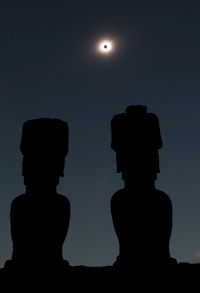
Stephane Guisard,Esater Island, Anakena beach
Jul. 11, 2010 #1, #2, more
Fantastic moment on the feet of the Ahu NauNau Moais. Weather got clear the same morning of the clipse, fantastic and unreal !
Glenn Schneider,
(see above) 18deg 10.8min South, 126deg 9.2min west (East of Tahiti) at 39,000 feet on an aircraft intercepting the centerline at 1920UT.
Jul. 11, 2010 #1, more
Quick look composite of 5 frames from 2500 km east of Tahiti at 39,000 feet on a centerline intercept jet charter. More to come later on the website! Duration of totality 9min23sec (not a typo - shadow chasing!)
Howard Brown-Greaves,
Anaa Atoll, French Polynesia
Jul. 11, 2010 #1
Taken from the South of Anaa Atoll on the Astro Expeditions tour. A small section from the main group set off on a pre-dawn convoy of 3 small but very powerful speedboats for a bone jarring 20 miles trip to the South of the remote Atoll where we enjoyed an extra 30 seconds of totality in stunning surroundings. Canon 40D, 24mm lens, 1/15th Sec.
Jay Pasachoff,
Easter Island
Jul. 11, 2010 #1, more
Eclipse 2010 Composite A solar eclipse photo (gray and white) from the Williams College Expedition to Easter Island in the South Pacific (July 11, 2010) was embedded into an image of the Sun's outer corona taken by the Large Angle Spectrometric Coronagraph (LASCO) and shown in red false color. LASCO uses a disk to blot out the bright sun and the inner corona so that the faint outer corona can be monitored and studied. Further, the dark silhouette of the moon was covered with an image of the Sun taken in extreme ultraviolet light at about the same time by NASA's Solar Dynamics Observatory (SDO). The composite brings out the correlation of structures in the inner and outer corona. Credits: Williams College Eclipse Expedition -- Jay M. Pasachoff, Muzhou Lu, and Craig Malamut; SOHO’s LASCO image courtesy of NASA/ESA and Naval Research Laboratory; solar disk image from NASA's Solar Dynamics Observatory; compositing by Steele Hill, NASA's Goddard Space Flight Center.
Francisco A. Rodriguez,
Atoll Tatakoto (French Polynesia). 1400km East from Tahiti.
Jul. 11, 2010 #1, #2, more
80mm f/5 Refractor + x2 duplicator + Canon EOS 350D. SAROS Group 2010 Expedition. www.saros.org
more images: from Cesare Guaita-Gruppo Astronomico Tradatese on Rapa Nui (Easter island); from Steve Harvey of Easter Island; from Brad Templeton of Hao, French Polynesia
Janne Pyykkö,
El Calafate, Patagonia, Argentina
Jul. 11, 2010 #1
The total solar eclipse 11-July-2010 in Argentina was not easy-to-catch, because the total phase appeared only 1 degree above the horizon and above the usually-cloudy Andes. To increase my possibilities, I hiked to a hill 400 meters above the lake Lago Argentino. With luck in weather I catched the phenomenon just over the mountains. I put myself into the photo to get a human touch. There was quite a strong wind during the eclipse which made me wish I had a better tripod.
Joerg Schoppmeyer,
El Calafate, Patagonia, Argentina
Jul. 11, 2010 #1, more
Celestron Refractor 600mm with 2x Converter + Canon EOS 40D
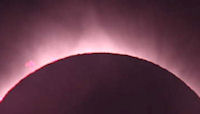
Constantinos Emmanouilidis,Mangaia Cook Islands
Jul. 11, 2010 #1, #2, #3
A small group of three astronomers traveled halfway around the globe to reach beautiful Mangaia. Here are the images we shot through the clouds.
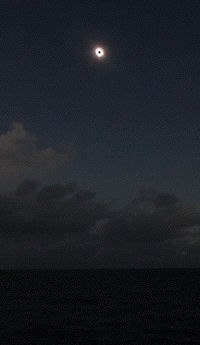
Patricia Reiff,off the coast of Tahiti
Jul. 11, 2010 #1, #2
Physics professor Patricia Reiff of Rice University witnessed the eclipse from the deck of the Aranui 3 cruise ship just off the coast of Tahiti. She sent these pictures directly from the ship using her iPhone.
Daniel Fischer,
80 km east of El Calafate, Santa Cruz, Argentina
Jul. 11, 2010 #1, #2, #3, #4, more
The shadow of the Moon sweeping over Patagonia in southern Argentina plunges the steppe east of El Calafate into darkness just before sunset on 11 July 2010. The sharp delineation of the Moon's umbra in the sky stunned everyone. Pictures taken with compact camera at various zoom settings.
Alejandro Tombolini,
Trenel, La Pampa, Argentina
Jul. 11, 2010 #1, #2
Solar Eclipse from the Argentine pampas. Images taken with a Canon Rebel XSi, using a telescope Willam Optics FLT 132 F/7.
Donald Gardner,
Atoll de Hao, French Polynesia, South Pacific
Jul. 11, 2010 #1, #2, #3, #4
Our group flew to this remote atoll (consisting of a coral reef surrounding a lagoon) about 550 miles east of Tahiti. The weather was perfect and the seeing was superb. The local people gave us a warm welcome with Polynesian dances. Photo details: Canon 7D with Takahashi FSQ-106ED, 400 ISO.
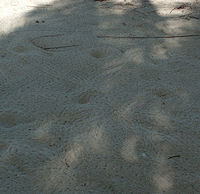
Malcolm Park,Hikuero Tahiti
Jul. 11, 2010 #1, #2, #3
from Hikuero Atoll east of Tahiti. We were in and out of clo
Francisco Diego,
Edge of Ranu Kau crater, Rapa Nui,
Jul. 11, 2010 #1, #2, #3, #4
Canon 450D Sigma 600mm catadioptric lens, composite image of 12 exposures from 1/500s to 2s Notice star delta geminorum on the left. Quite dynamic corona.
Carlos Caccia,
Intendente Alvear, La Pampa Argentina
Jul. 11, 2010 #1
Solar Eclipse from Argentina´s pampas.
Mariano Ribas,
Pehuajó, 370 kilometers Southwest of Buenos Aires, Argentina
Jul. 11, 2010 #1, #2, #3
I took these images of the solar eclipse from Pehuajo, a small city 370 kilometers southwest of Buenos Aires. It was a partial eclipse, with the moon covering 54% of solar diameter.
Robert Stephens,
South of Tahiti at approximately 18 degrees, 28 minutes South, 147 degrees, 9 minutes West.
Jul. 11, 2010 #1
A panorama of the Total Solar Eclipse taken on board the Paul Gauguin. Part of the ship's crew is in the foreground watching the eclipse. Canon G10 in Panorama mode. Three images each at ISO 200, F/2.8 and 1/10 second.
Terry Evans,
Hao Atoll, French Polynesia
Jul. 11, 2010 #1, #2, #3
11th July was my birthday and this was the second (and last) eclipse on my birthday in my lifetime. These images were taken from Hao Atoll,French Polynesia. I used my trusty vintage 1975 400mm telephoto with a Canon 300D. Images of the chromosphere just after 2nd contact, inner corona and prominences mid eclipse and the 3rd contact diamond ring. We had very thin cloud and a pesky thicker patch just at the end. Shadow bands were visible on the sand just after 3rd contact.
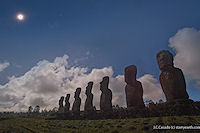
Juan Carlos Casado,Ahu Akivi site, northwest of Easter Island, from Shelios 2010 expedition (www.shelios.com/sh2010)
Jul. 11, 2010 #1, #2, #3, more
Spectacular eclipse!!!
Hikueru Atoll, French Polynesia
Jul. 11, 2010 #1, #2, #3, more
A group of about 40 international travellers, including 14 Canadians, were at the airport on Hikueru atoll in the Tuamotu chain of atolls in French Polynesia. Unfortunately, cloud moved in at the wrong time (just at second contact) and obscured the Sun through totality. Had the eclipse occurred 5 minutes earlier we would have seen it. People further down the island in the village did see the eclipsed Sun in the clear -- the cloud was that low and local. The fish-eye shot shows the entire sky (most of it clear and with stars showing) at the moment of second contact diamond ring.
Blas Servín,
Asunción, Paraguay
Jul. 11, 2010 #1, #2, more
El Eclipse del domingo 11 de julio, visto como parcial desde Asunción, Paraguay.
Alson Wong,
Paul Gauguin, French Polynesia
Jul. 11, 2010 #1, #2, #3, #4, more
Six separate exposures from 1/500 to 1/15 second were digitally combined to create the image of the corona. I used a Nikkor 300 mm f/4 lens with a Nikon D300 at ISO 200. The third contaact and Baily's Bead images were 1/8000 second exposures. The diamond ring exposure was 1/500 second. For the wide angle image I used a Nikon D70 with a 18-200 mm f/3.5-5.6 lens working at 18 mm and f/3.5, with a 1/4 second exposure at ISO 400.
On board the Aranui 3 off the coast of Hikuero Tuamotu, French Polynesia
Jul. 11, 2010 #1, #2, #3, more
After an accident that damaged my primary camera just 22 hours before the eclipse, I was forced to learn a backup camera and use it to shoot the eclipse. Canon Digital Rebel XTi, 18mm-270 Tamron lens at 18mm, 400 ISO, 1/6s at f/5. Diamond ring shot at 1/40 at f/5. All were hand he
отсюда
Статус: |
Группа: Гости
публикаций 0
комментариев 0
Рейтинг поста:
ФОБОС
Знаменитые истуканы острова Пасхи веками встречают рассветы и провожают закаты. Но вот однажды, 11 июля 2010 года, этот нескончаемый цикл был прерван странным событием – темнотой посреди белого дня. Особое расположение Солнца, Луны и Земли отбросило лунную тень на крошечный остров в Тихом океане, площадь которого составляет 170 кв. км. В результате, гигантские моаи, как их называют аборигены, были вынуждены в разгар белого дня провести 5 минут 20 секунд в темноте.
http://news.gismeteo.ru/news.n2?item=63414788314